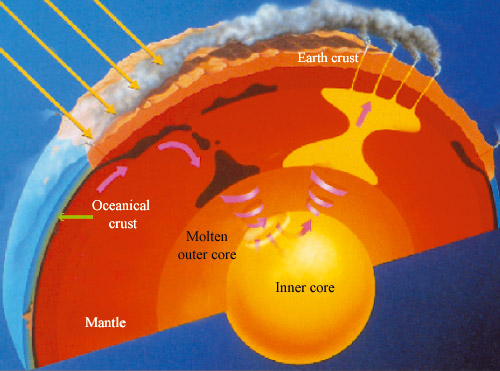A temperate planet
Our planet is warm. The pleasant conditions we enjoy on its surface are principally due to the radioactive processes taking place at its centre. The Earth radioactivity causes our planet to behave like an immense hot-water bottle: slowing down the cooling rate and consequently making it habitable. A small half of the heat necessary for our survival is released by the radioactive disintegrations which take place in the rocks that form our Earth crust. The other half of the released power comes mainly from the very slow cooling of the Earth since its formation, which is called the secular cooling.

The blue planet
Radioactivity has played a major role in giving the Earth its blue and friendly appearance, by preventing it from cooling down. Together with the heat produced by the Sun, it has also guaranteed the pleasant temperatures necessary for life as we know it.
© CEA
At the end of the nineteenth century, the British physicist Lord Kelvin had calculated from the flux of heat emerging from the ground that the age of the Earth could not exceed 100 million years. But Lord Kelvin was unaware of the disintegration of radioactive elements …
The thermal energy emerging from the ground has been estimated to be around 46 trillion watts (46 TW or terawatts), including 2 TW from volcanic eruptions and earthquakes. Apart from earthquakes and volcanic eruptions, most of this geotherma flux is released in a continuous way. This is called the geothermal flow.

A permanent source of heat:
The bowels of the Earth closely resemble a giant thermal power station, powered by convection currents that heat the surface using energy from the rocks buried underground. At the very centre of this giant factory one have the inner and the molten outer cores. Moving outwards, one have the terrestrial mantle, followed by the Earth’s crust. The outer layer of the mantle and the whole of the crust are referred to as the lithosphere: a puzzle comprised of twelve enormous tectonic plates that move against each other to the rhythm of powerful subterranean currents. These boundaries between tectonic plates are where the Earth’s inner workings can most clearly be seen; as these are places where one frequently finds earthquakes and volcanoes.
© CNRS
A part of this geothermal flow – between 15 and 25 TW – is due to a small but constant heat release resulting from the disintegration of long lived radioactive atoms present in the Earth. Owing to the extremely long lifetimes (several billions of years) of surviving radioactive atoms, the heat releases are very small : very small, since the heat flux amounts around 0,1 watt/m2. it would take many tons of earth merely to power a light bulb. Quasi constant, since this release has only halved since the formation of the Earth.
The total heat release includes the contribution of the descendants of uranium-238, including radium, which are in radioactive equilibrium with their ancestor and whose generally alpha decays lead to similar heat releases. The same applies to uranium-235 and thorium-232 families. On the whole, taking into account the decays of descendants amounts to multiply the energy release of uranium-238, uranium-235 and thorium-232 by around 10.
While the heat released by these radioactive atoms is small, the amounts of these radioactive elements in the Earth are also small. However, at the Earth scale, the quantities become enormous. The uranium and thorium amounts in the Earth crust and mantle are estimated respectively to 50,000 and 160,000 billion tons. According to this estimate, uranium alone would release the electrical energy produced by 4620 nuclear power plants of 1 Gigawatt.
The decay heat has somewhat decreased since the Earth formation, 4 billions years ago. Radioactive elements with a shorter lifespan that were present have vanished. The Earth enormous size guarantees that only a small fraction of this generated heat will emerge from the ground. The decay heat flux which is on the order of a few milliwatts per tonne for uranium and thorium, is lower for potassium because it contains very little radioactive potassium-40 (0.0117%), although Potassium is more abundant in the earth’s crust.
Geothermal energy is one of the renewable energies considere today. Can one exploit this considerable source coming from the Earth, part of which is of radioactive origin? This energy is generally too dispersed to be recovered: The geothermal flux of 80 milliwatt per square meter would require an area of 1000 m2 to power a single 80-watt bulb! On the other hand, heat accumulated in deep waters has been used for urban heating in the Paris Basin. Underground steam has been used to produce electricity in volcanic regions like Iceland.